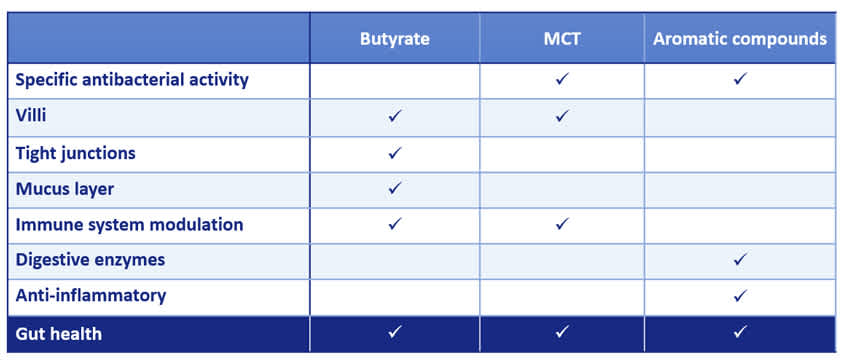Effectively fight against challenges with Palital’s optimal gut health promoting solutions

Animal performance is limited by the varied and frequent challenges and stress that animals encounter during the production cycle. The use of antibiotic growth promoters and ZnO are decreasing worldwide due to environmental and antimicrobial resistance concerns. This means that other suitable solutions are needed to improve gut health and minimize health issues such as necrotic enteritis and dysbacteriosis. However, a lot of different concepts are available that differ in terms of their main modes of actions. In this article, we focus on three concepts which are all within the Palital product range: butyrate, aromatic compounds and medium-chain triglyceride (MCT).
Stimulation of a well-balanced microbiota
The gut microflora, particularly in the small intestine, is a key parameter to keep in balance in order to achieve optimal gut health. MCT, as well as aromatic compounds, can be considered as antibacterial components due to their direct action on bacterial cell membranes and intracellular pH. They also can work together synergistically, which delivers enhanced benefits including efficiently overcoming issues associated with dysbacteriosis.
Specificity is a key parameter to consider when promoting a balanced microbiota. MCTs are specific against particular types of bacteria. For example, caproic and caprylic acids act on the Gram-negative bacteria Salmonella and E. coli. On the other hand, lauric acid acts on the Gram-positive bacteria Streptococcus suis and Clostridium perfringens. Moreover, they all promote a better environment for beneficial bacteria, e. g. Lactobacillus and Bifidobacterium.
Promoting gut integrity
Both butyrate and MCT have several benefits on gut morphology, such as increasing the villus height. This results in an increased gut surface area, and improved absorption of available nutrients. They are also an energy source for epithelial cells. These effects are complemented by the action of aromatic compounds, which can increase the secretion of digestive enzymes.
In addition to its effect on villus structure, butyrate also strengths the intestinal barrier and improves its permeability by facilitating tight junction assembly. Tight junctions close the gaps between epithelial cells and prevent the passage of toxins, microorganisms and feed material into the tissues and blood stream. If gut permeability is too high then leaky gut syndrome occurs, which cause inflammation and immune system challenge.
As well as acting at the tissue level, butyrate can improve the mucus layer by beneficially influencing gene expression and mucin protein secretion. This is a key action, as the mucus layer provides physical protection for the epithelium against pathogens.
Immune system modulation
A weakened immune system often occurs when the animal has a disease or stress challenge. The supplementation of butyrate activates expression of certain genes linked to immune system function. For example, stimulating macrophages which detect and destroy pathogenic bacteria and other harmful pathogens. Both butyrate and MCTs can also decrease virulence gene expression in certain pathogenic microorganisms, which can decrease their invasiveness.
Butyrate also promotes antimicrobial peptides (AMPs), which have antimicrobial as well as immunomodulatory functions. This results in the AMPs being crucial for both the prevention and clearance of infection. Regulation of inflammation is also a key benefit of aromatic compounds, which are anti-inflammatory components that lower the expression of pro-inflammatory cytokines.

Figure 1 – Main modes of actions of butyrate, medium-chain triglyceride and aromatic compounds.
In conclusion, various complementary solution options exist to support optimal gut health (Figure 1). These products stimulate performance by balancing the microbiota, promoting gut integrity and modulating the immune system. This enables dietary nutrients and energy to be more efficiently used for growth and performance, rather than fighting disease, resulting in an economical usage of the feed by the animal. For more information on the different solutions available at Palital, please just get in contact with us.
Literature references available on request.